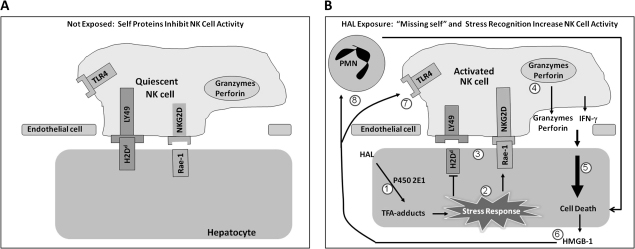FIG. 7.
Proposed mechanism of innate immune-mediated severe HAL-induced liver injury. (A) In the absence of stress stimulation, self-proteins such as H2Dd are expressed on the plasma membrane of hepatocytes and RAE-1 is not; this condition keeps NK cells quiescent. (B) When hepatocytes are exposed to HAL, intracellular TFA adducts form (1). This induces a stress response in hepatocytes (2) that alters the surface NK receptor ligands (3) and activates NK cells. Activated NK cells release IFN-γ as well as the contents of cytotoxic granules (4), such as perforin and granzyme B, which contribute to hepatocellular necrosis (5). Damaged hepatocytes release endogenous danger signals, such as HMGB-1 (6). These endogenous danger signals are ligands for TLR4 (7), and the resultant signals are involved in a positive feedback loop that further activates NK cells as well as recruits polymorphonuclear leukocytes (PMNs) (Scaffidi et al., 2002) that participate (8) in the progression of injury (Dugan et al., 2010).

